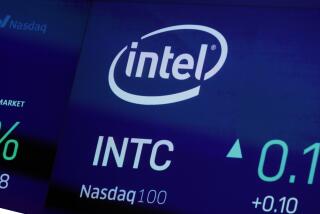Intel Produces Trimmer Chip, Lowers Costs
- Share via
Computer chip giant Intel Corp. plans to introduce today a new generation of microprocessors that represents a breakthrough in production techniques more than in performance and that carries significantly lower manufacturing costs.
The chips for desktop computers, which will continue to go by the brand name Pentium 4, will be available in versions with clock speeds of 2.8 to 3.4 gigahertz. That compares with the previous generation’s clock speeds of up to 3.2 GHz.
The older chips will remain on the market but will be rapidly replaced. A super-fast 4.0 GHz version of the new P4 chip is expected to come out by the end of the year, said Bill Siu, an Intel vice president who is general manager of the Desktop Platforms Group.
The latest P4s are made with their smallest features only 90 nanometers long, or about 1,500 times more narrow than a human hair. The previous generation’s smallest features were 130 nanometers. The new chips, though smaller, can hold 125 million transistors, compared with 55 million transistors on the 130-nanometer chips.
And this generation is being produced on wafers about 12-inches wide, replacing wafers about eight-inches wide.
“This represents a tremendous boost in terms of capacity, improving cost and overall availability of the product,” Siu said Friday.
Increasing chips’ clock speed, or frequency, “was clearly more difficult to do at 130 nanometers,” said Nathan Brookwood, who runs the Silicon Valley consultancy Insight64.
“This transition gives Intel the chance to ramp up the clock frequency, and you couldn’t do that unless you transfer to the new production geometry.”
Producing tinier chips on bigger wafers reduces costs by about 30%, Siu said, allowing Intel to price the new chips at $178 for the 2.8GHz version to $417 for the 3.4 GHz chip in lots of 1,000. The savings will be passed on to computer makers and ultimately to consumers, he said.
The new chips also introduce some new technologies, notably “strained silicon,” in which a strain is introduced to the latticework of silicon atoms to allow electricity to flow faster, resulting in faster processing speeds.
“This is really the first microprocessor to exploit strained silicon, and here Intel is bringing it to the masses, and I mean masses,” Brookwood said. “The whole chip is a technological tour de force.”
The chips have been produced at Intel fabrication plants, or “fabs,” in Oregon and New Mexico; they will eventually also be made at Intel fabs in Ireland and Israel.
Shipments to customers began in the last quarter of 2003.
Computers from 29 manufacturers -- including Dell Inc., Hewlett-Packard Co., IBM Corp., Sony Corp., Alienware Corp. and Acer Inc. -- are being built with desktop systems with the new 90-nanometer P4 chips.
The systems will be designated by an “E” such as “Pentium 4 Processor 3.4E.”
Siu declined to say during a briefing with reporters whether the new P4 chips have additional capabilities that can be activated at a later date, such as enhanced security features or 64-bit computing -- the ability to process data at twice the rate of the current computing standard of 32 bits.
In addition to making the P4 announcement, Intel today will unveil two 3.4 GHz chips built on the 130-nanometer technology, targeted at high-end gamers and power-computing users.





